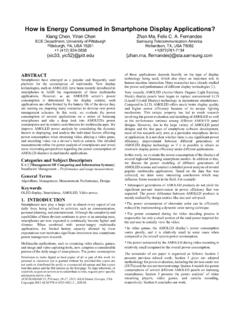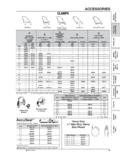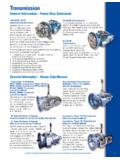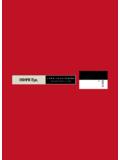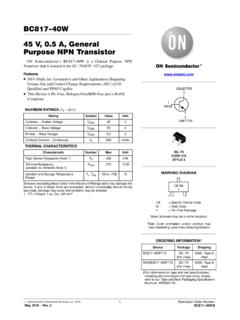Transcription of Open Data Kit 2.0: Expanding and Refining …
1 Open Data Kit : Expanding and Refining information services for developing Regions Waylon Brunette, Mitchell Sundt, Nicola Dell, Rohit Chaudhri, Nathan Breit, Gaetano Borriello Department of Computer Science and Engineering University of Washington Box 35350, Seattle WA, 98195, USA {wrb, msundt, nixdell, rohitc, nbnate, ABSTRACT Open Data Kit (ODK) is an open-source, modular toolkit that enables organizations to build application-specific information services for use in resource-constrained environments. ODK is one of the leading data collection solutions available and has been deployed by a wide variety of organizations in dozens of countries around the world. This paper discusses how recent feedback from users and developers led us to redesign the ODK system architecture.}
2 Specifically, the design principles for ODK focus on: 1) favoring runtime languages over compile time languages to make customizations easier for individuals with limited programming experience; 2) implementing basic data structures as single rows within a table of data; 3) storing that data in a database that is accessible across applications and client devices; and 4) increasing the diversity of input types by enabling new data input methods from sensors. We discuss how these principles have led to the refinement of the existing ODK tools, and the creation of several new tools that aim to improve the toolkit, expand its range of applications, and make it more customizable by users.
3 Categories and Subject Descriptors information Systems Applications General Terms Design Keywords Open Data Kit, mobile computing, smartphones, ICTD, sensing, mobile databases, spreadsheets, data tables, paper forms, vision. 1. INTRODUCTION Smartphones are rapidly becoming the platform of choice for deploying data collection and information services in the developing world. They have quickly leap-frogged desktop and laptop computers due to their mobility, increased independence from the power infrastructure, ability to be connected to the internet via cellular networks, and relatively intuitive user interfaces enabling well-targeted applications for a variety of domains.
4 In effect, developing countries are skipping the desktop and laptop phase of computing development, and are instead using smartphones and tablets for a range of tasks that have traditionally been performed on larger machines. In concert with this development, cloud services are providing many organizations with the ability to easily rent data storage space and scale hosting resources as needed, either locally or anywhere in the world. We recognized two trends - 1) capable client devices with rich user interfaces and 2) cloud-based scalable data collection, computing, and visualization services - several years ago when we began the Open Data Kit (ODK) project at the University of Washington.
5 Through ODK, we sought to create an evolvable, modular toolkit for organizations with limited financial and technical resources to use to create data collection and dissemination services . We chose Android as our development platform because its flexible inter-process communication methods allowed us to use existing apps for taking pictures, scanning barcodes, and determining location, rather than having to rewrite them ourselves, thus speeding development. ODK s development was guided by a few simple principles, namely: Modularity: create composable components that could be easily mixed and matched, and used separately, or together; Interoperability: encourage the use of standard file formats to support easy customization and connection to other tools; Community: foster the building of an open source community that would continue to contribute experiences and code to expand and refine the software; Realism: deal with the realities of infrastructure and connectivity in the developing world and always support asynchronous operation and multiple modes of data transfer.
6 Rich user interfaces: focus on minimizing user training and supporting rich data types like GPS coordinates and photos; Follow technology trends: use consumer devices to take advantage of multiple suppliers, falling device costs, and a growing pool of software developers. The name ODK refers to the entire suite of modular tools. Each tool in the suite has been assigned a name that describes its function. Previous work has discussed ODK [6], which consisted of three primary tools: Build, Collect, and Aggregate. These provide the ability to design forms, collect data on mobile devices ( phones, tablets), and organize data into a persistent store where it can be analyzed.
7 Prior papers have also described the design of several new tools that are being incorporated into the ODK suite: Sensors [1], Scan [3] and Tables [7]. As we deployed the original tools, gathered feedback from users, and sought to incorporate new tools into the ODK suite, it became clear that there were some deficiencies in our design that needed Permission to make digital or hard copies of all or part of this work for personal or classroom use is granted without fee provided that copies are not made or distributed for profit or commercial advantage and that copies bear this notice and the full citation on the first page. To copy otherwise, or republish, to post on servers or to redistribute to lists, requires prior specific permission and/or a fee.
8 ACM HotMobile'13, February 26-27, 2013, Jekyll Island, Georgia, USA. Copyright 2013 ACM 978-1-4503-1421-3 ..$ to be addressed. This paper describes these deficiencies, and the rationale that drove a redesign of the inter-tool architecture of the tool suite, which will be released under the ODK label. ODK has quickly become one of the leading solutions for a wide variety of organizations, from small NGOs to large government ministries, and now has thousands of users in dozens of countries around the world. The projects for which it is being used range over an ever-increasing set of domains including public health (our original focus), environmental monitoring, and documenting human rights abuses.
9 The ODK website has been visited by over 65,000 unique visitors from 202 different countries/territories and averages over 8500 hits a month. Additionally, over 11,000 distinct users have installed Collect from Google Play (a number that does not include organizations that install Collect directly when setting up their deployment). From our users collective experience using ODK, we have seen many ways to improve the toolkit, expand its range of applications, and make it even more customizable. Recently, we conducted an extensive survey of the ODK user and developer community to better understand how people are using ODK and how organizations data collection needs are evolving.
10 73 organizations completed our survey, providing information on 55 different deployments involving at least 5500 mobile devices in over 30 countries. This vast amount of feedback, in conjunction with the numerous deployment reports and feature requests submitted to our mailing list and website, led us to rethink the ODK system architecture. This paper reports on the changes that we are now implementing to our system architecture and applications, and the rationale behind each. 2. LIMITATIONS OF ODK Our observations and survey responses can be grouped into four principal areas of refinement for ODK: 1. support data aggregation, cleansing, and analysis/visualization functions directly on the mobile device by allowing users to view and edit collected data; 2.
